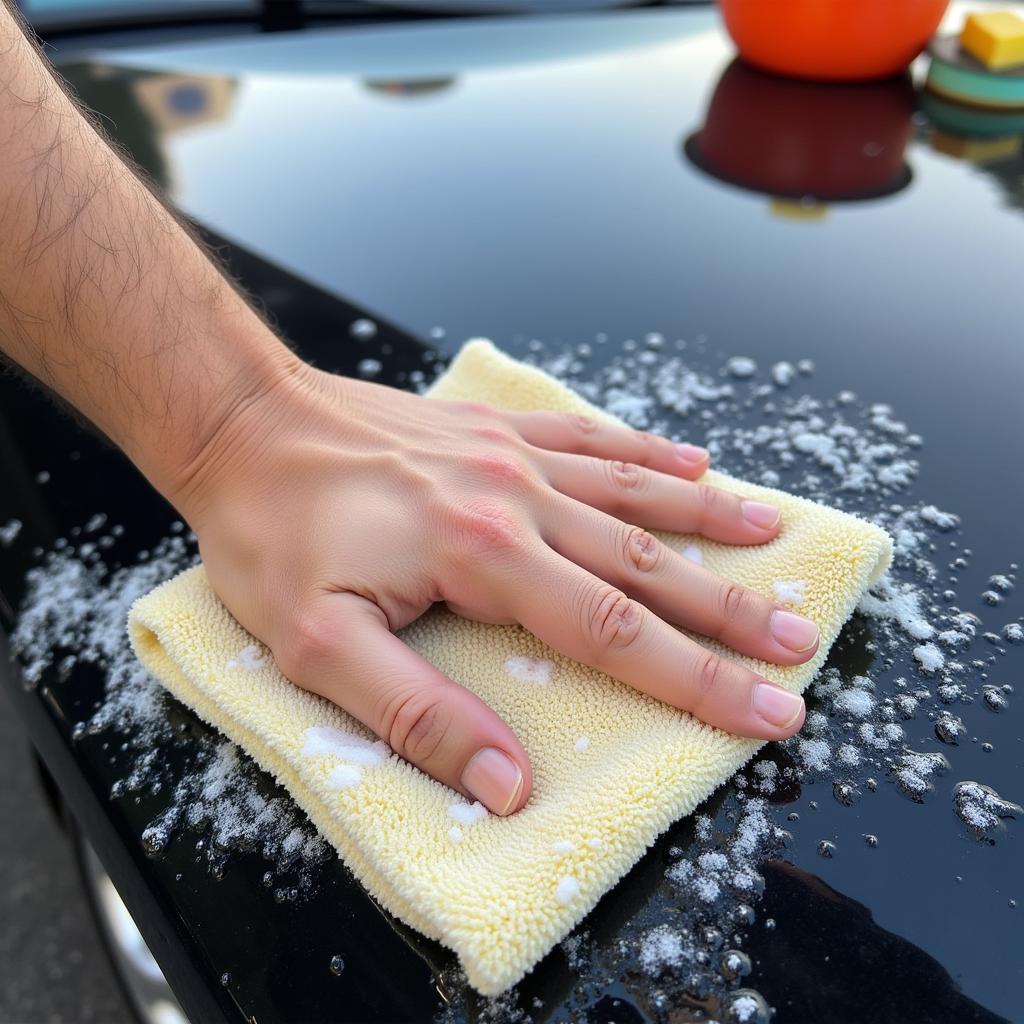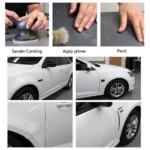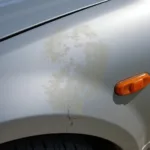Minor car paint damage, like scratches and chips, are an inevitable part of car ownership. While they might seem small, they can detract from your car’s appearance and, if left untreated, lead to more serious problems like rust. Fortunately, you can often repair minor car paint damage yourself, saving you a trip to the body shop. This guide will walk you through the process of identifying the damage, choosing the right repair method, and executing the repair like a pro.
After assessing the damage, you’ll need to gather the necessary supplies. For most minor repairs, you’ll need items like car wash soap, microfiber towels, rubbing compound, polishing compound, touch-up paint, clear coat, fine-grit sandpaper, and masking tape. For deeper scratches, you might also need primer. Remember, proper preparation is key to a successful repair. A thorough cleaning ensures that dirt and debris don’t further scratch your car during the repair process. repair minor paint damage for a car provides more details on the materials needed and the overall repair process.
Identifying the Type of Car Paint Damage
Before starting any repair, it’s crucial to identify the type of damage you’re dealing with. Is it a light scratch, a deep scratch, a chip, or a scuff? Each type of damage requires a slightly different approach. Light scratches often only affect the clear coat and can be addressed with polishing compound. Deeper scratches that penetrate the color coat will require touch-up paint. Chips expose the bare metal and need to be addressed promptly to prevent rust.
Gathering Your Supplies for Car Paint Repair
Choosing the right supplies is essential for achieving a professional-looking repair. Using high-quality products designed specifically for automotive paint will yield the best results. Don’t skimp on the quality of your microfiber towels, as they play a critical role in applying and removing the various compounds and polishes.
Step-by-Step Guide to Repairing Minor Car Paint Scratches
- Wash and Dry: Thoroughly wash and dry the affected area to remove any dirt or debris.
- Assess the Damage: Determine the depth of the scratch.
- Sanding (If Necessary): For deeper scratches, use fine-grit sandpaper to smooth the edges of the chipped paint.
- Masking: Mask off the surrounding area to protect the undamaged paint.
- Primer (If Necessary): If the scratch has reached the bare metal, apply a thin coat of primer.
- Apply Touch-Up Paint: Carefully apply touch-up paint to the chipped area, using a fine-tipped brush or a touch-up pen.
- Apply Clear Coat: After the touch-up paint has dried, apply a thin layer of clear coat.
- Wet Sanding and Polishing: Once the clear coat has dried, wet sand the repaired area with very fine-grit sandpaper and then polish with rubbing and polishing compound to blend the repair seamlessly.
How to Repair Minor Car Paint Chips
Chips, while small, can lead to significant rust issues if not addressed promptly. The repair process is similar to repairing scratches but often requires more attention to preventing rust. After cleaning and sanding the chipped area, you’ll want to apply a rust inhibitor primer before applying touch-up paint and clear coat. Cost to repair minor paint damage for a car offers insights into the cost-effectiveness of DIY repairs compared to professional services.
What Causes Minor Car Paint Damage?
Minor car paint damage can be caused by various factors, including rocks and debris on the road, minor collisions, tree branches, and even improper washing techniques. Understanding the causes can help you take preventative measures to protect your car’s finish. Car paint mobile repair is a great option for those seeking convenient repair solutions.
Tips for a Professional-Looking Finish
- Use thin coats of paint and clear coat to avoid runs and drips.
- Allow each coat to dry completely before applying the next.
- Use high-quality polishing compounds and microfiber towels for the final polishing stage.
- Be patient and take your time. Rushing the process can lead to mistakes and a less-than-perfect finish.
“Patience is key when repairing minor paint damage,” advises John Smith, an automotive detailing expert with over 20 years of experience. “Taking your time with each step will ensure a much better outcome.”
Conclusion
Repairing minor car paint damage yourself can save you money and is often a manageable DIY project. By following the steps outlined in this guide, you can achieve professional-looking results and maintain your car’s appearance. Don’t let minor scratches and chips detract from your car’s beauty; tackle them head-on with the right knowledge and tools to keep your vehicle looking its best. Remember to always clean the area thoroughly before starting any repair. For information on blending paint, check out blending paint car repair. Doncaster mobile car paint repair can be helpful for those in the Doncaster area.
FAQ
- How long does it take for touch-up paint to dry?
- Can I use regular nail polish for touch-up paint?
- What grit sandpaper should I use for wet sanding?
- How can I prevent car paint damage?
- What is the best way to remove scuff marks from my car?
- How do I match the touch-up paint to my car’s color?
- How deep of a scratch can I repair myself?
Do you have other questions about car paint repair? Explore more articles on our website for further guidance.
Need Help? Contact us via WhatsApp: +1(641)206-8880, or Email: [email protected]. Our 24/7 customer support team is ready to assist you.



